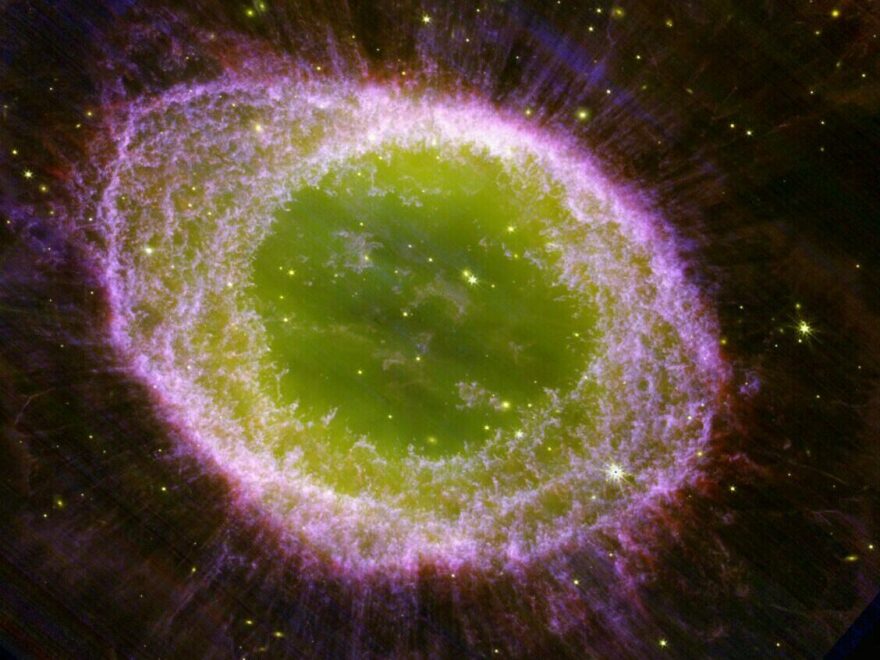Gone are the days when the Ring Nebula looked sort of like a bagel, or a jelly doughnut, a massive astronomical blob holding the secrets of a dying star.
The new images of the famous Ring Nebula from NASA's James Webb Space Telescope are mesmerizing, with glowing rings of gas and wispy trails emanating from the core. We can see it in more clarity than ever, including thousands of clumps that make up its main ring.
"We always knew planetary nebulae were pretty. What we see now is spectacular," Albert Zijlstra, an astrophysics professor at the University of Manchester, said in a statement about the new image.
The image was released by an international team of researchers, including experts from the U.K., France, Canada, the U.S. and other countries. It has given them a lot to study.
"The high-resolution images not only showcase the intricate details of the nebula's expanding shell but also reveal the inner region around the central white dwarf in exquisite clarity," said Mike Barlow, lead scientist of the JWST Ring Nebula Project.
The new image shows vibrant colors and new detail
"Just like fireworks, different chemical elements in the nebula emit light of specific colors," as University College London states. That does more than produce eye-popping scenes in space; it also lets astronomers study the chemical makeup and evolution behind the spectacle.
Despite its name, a planetary nebula is actually the remains of a sun-like star. And the closer astronomers look, the more complex planetary nebulae prove to be, with numerous clumps of gas and filaments radiating outward.
"Planetary nebulae were once thought of as very simple objects, roughly spherical and with a single star at their centre," said Roger Wesson, a research associate at Cardiff University who led the image analysis. "Hubble showed that they were much more complicated than that, and with these latest images JWST is revealing yet more intricate detail in these objects."
For comparison to the new image, here's a Hubble Space Telescope image of the Ring Nebula that caused a stir 10 years ago, when it showed more complexity than had been seen before:

You can see the Ring Nebula for yourself
The Ring Nebula, also known as Messier 57, is more than 2,000 light years away, in the Lyra constellation. Discovered in 1779 by a French astronomer, it doesn't take a fancy instrument for an amateur astronomer to spot from their back yard.
"I first saw the Ring Nebula as a kid through just a small telescope," said astrophysicist Jan Cami of Western University in Ontario and the JWST Ring Nebula Imaging Project in a statement about the new image.
"I would never have thought that one day, I would be part of the team that would use the most powerful space telescope ever built, to look at this object," Cami said.
If you want to try to spot the Ring Nebula on your own, you're in luck: Summer is the best time to view it, and August is perfect, according to NASA. One way to find Lyra is by looking for its bright star, Vega.
The nebula is expanding as its star dies
"We are witnessing the final chapters of a star's life, a preview of the sun's distant future so to speak," Barlow said, adding, "JWST's observations have opened a new window into understanding these awe-inspiring cosmic events."
The spectacle began around 4,000 years ago, when the Nebula Ring's central star, which was more massive than our sun, expelled gases from its outer layers into space. For billions of years, the star had been converting hydrogen to helium — but it started to run low on fuel.
"It then ballooned in size, becoming a red giant," according to NASA. "During this phase, the star shed its outer gaseous layers into space and began to collapse as fusion reactions began to die out. A gusher of ultraviolet light from the dying star energized the gas, making it glow. The outer rings were formed when faster-moving gas slammed into slower-moving material."
The nebula is still expanding — estimated at more than 43,000 miles an hour, NASA says. It's expected to keep that up for the next 10,000 years or so.
Copyright 2023 NPR. To see more, visit https://www.npr.org.



